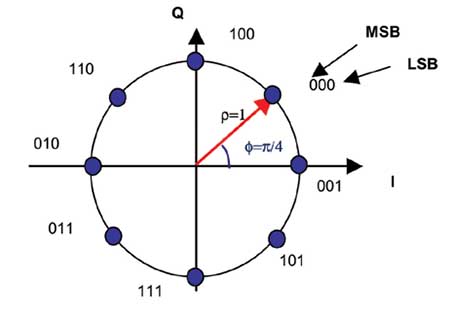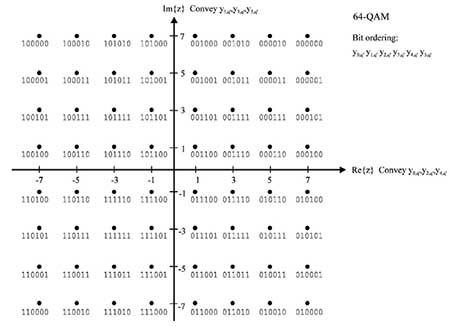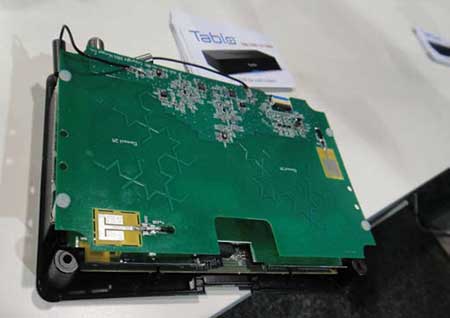
Doug Lung
Digital transmission puts extra demands on amplifier linearity. TV transmitter engineers are well aware of this, but operators of terrestrial and satellite digital transmitters might not always realize when signal problems are caused by nonlinearity in mast-mounted ENG amplifiers or satellite uplinks.
Analog transmission of video over satellite or terrestrial microwave used frequency modulation, and except for intermodulation between the sound carriers, amplifier non-linearity wasn’t a major problem.
High-speed digital transmission requires more complex signals. Simple QPSK modulation, which carries the digital data as shifts in the phase of the carrier in one of four quadrants (Fig. 1), is quite robust, but doesn’t provide the data rate needed for HD video after forward error correction is added.

Fig. 1: QPSK Constellation from ETSI EN 300 744 v1.6.1 Digital satellite uplinks typically use 8PSK—the data is coded into one of eight different phases (Fig. 2). Fixed digital microwave links often use 16QAM or 64QAM, which is an even more complex signal (Fig. 3). For ENG microwave, COFDM provides more robustness through modulation of thousands of carriers typically modulated with QPSK, 16QAM or 64QAM. From these diagrams you can see it wouldn’t take much distortion for one symbol to be confused with another.
OVER-POWERED AMPLIFIERS CREATE INTERFERENCE
When ENG microwave links fail, the temptation is to up the power. That can help, until the amplifier is driven into nonlinearity, where increasing input level doesn’t increase output level by the same proportion. One clue the amplifier is overdriven is a decreasing signal-to-noise ratio (SNR) at the receiver even though the received signal strength is increasing. The noise and distortion is occurring in the amplifier and there is nothing that can be done on the receive end to remove it.
The professional video industry's #1 source for news, trends and product and tech information. Sign up below.

Fig. 2: 8PSK Constellation from ETSI EN 302 30 v1.2.1 If the required SNR can’t be achieved even with a power reduction, then the only option is to select a more robust transmission mode and live with the lower data rate. The amplifier nonlinearity also leads to spectrum regrowth, which can be seen on a spectrum analyzer.
Before being transmitted the digital data is coded with additional bits that are used to reconstruct the signal if some of the bits are lost. The “coding rate” is the ratio of original data bits to the coded data bits.
For example, in three-quarter-rate coding, four bits are transmitted for every three data bits. Lower rates are more robust— for half-rate coding, twice as many bits are sent as in the incoming data. Most digital ENG gear uses the DVB standard specified in ETSI EN 300 744 (http://tinyurl.com/nl4g9tg).
That document describes the modulation and coding and Annex A shows simulated system performance for 8 MHz-wide channels. For example, a half-rate (1/2) QPSK signal can carry around 5 Mbps if the carrier-to-noise (C/N) ratio is 4 dB or better. If a 15 Mbps data rate is required, the required C/N increases to around 15 dB. The exact rates depend on the guard interval and channel conditions (see Annex A for details).

Fig. 3: Q64-QAM Constellation from ETSI EN 300 744 v1.6.1 Mast-mounted amplifiers originally designed for analog (FM) do not work well for digital transmission. Phase and amplitude nonlinearity in the amplifiers limit usable power to less than half the rated analog power. Microwave modulator and amplifier technology has improved significantly since the Sprint/Nextel 2 GHz digital conversion, and it might be time to upgrade those older amplifiers! Since Nextel did not cover the cost of replacing mast amplifiers for 6.5 GHz and 7.0 GHz spectrum, stations may be tempted to use their new digital modulators with these older amps. Results are likely to be disappointing. If replacing older amplifiers isn’t an option, consider switching to H.264 video encoding at a lower data rate and using more robust modulation and/or a lower code rate.
The same problems can occur in satellite links. While typically less of a problem due to the sensitivity of today’s satellite transponders, solid-state or TWT amplifiers in the uplink can be over-driven if the device is failing or when compensating for rain fade. As with terrestrial microwave links, indications of too much power include spectrum regrowth (visible on the downlink spectrum) or SNR and BER worse than expected for the link. Too much signal into the satellite transponder is another concern. It will affect other users and incur the wrath of the satellite operator
TABLO METRO

The Tablo Metro picks up an over-the-air signal and streams it over a Wi-Fi network to an OTT device or directly to a tablet or smartphone for handheld viewing or casting to a TV. One of the more interesting products I saw at CES in January was the Tablo Metro. The Metro has two built-in antennas. While many consumers aren’t afraid to set up an antenna (indoors or outdoors)—as evidenced by the strong sales numbers from companies like Antennas Direct and the appearance of new antenna products—the need to install and connect an antenna may discourage some people from trying over-the-air TV. The Tablo Metro makes it much easier for people to integrate over-the-air TV with streaming video services.
As you can see from the photo, the two antennas are oriented differently and the Metro selects the best one for each channel. This should avoid the need to move the box around to pick up different stations. Nuvyyo, Tablo Metro’s manufacturer, says the antennas should provide reception up to 25 miles or so from the transmitter site.
A key difference between the Metro and conventional TV antennas/tuners is that the Metro, like other Tablo TVs, does not connect directly to the TV set or display. It picks up the over-the-air signal and streams over the home’s Wi-Fi network to an Amazon Fire stick or box, Apple TV, Chromecast, Roku device connected to the TV or directly to a tablet or smartphone for handheld viewing or casting to a TV.
The Tablo Metro with external antenna can be located away from the TV and placed in a location where it will get good reception—an upstairs room or near a window facing the TV transmitters, for example. When the time comes to switch to ATSC 3.0, a box like the Tablo Metro could provide the 21st Century equivalent of the set-top converter box!
RF REPORT POST MORTEM
One final note: TV Technology’s publisher has decided to discontinue my weekly RF Report newsletter. RF Report began as “RF Current” on www.transmitter.com over 19 years ago, on Nov. 13, 1995, and ended Jan. 22, 2001, after I found it difficult to devote sufficient time to it. In early 2003, TV Technology launched “Doug Lung’s RF Report,” where I covered the DTV transition and more recently news about the FCC’s incentive auction and repacking.
If you’d like me to reinstate my old “RF Current” newsletter to provide more current coverage of RF news, please let me know at dlung@transmitter.com. Comment on what areas you find most interesting. For now, I’ll take advantage of having my evenings back to spend some time updating www.transmitter. com, posting older TV Technology columns on my site and indexing them. I intend to keep up with the latest developments in RF technology, including new technologies like 5G and scientific research, and will cover major items in my RF Technology column. Thanks for your support!
Comments are welcome! E-mail me atdlung@transmitter.com.

Doug Lung is one of America's foremost authorities on broadcast RF technology. As vice president of Broadcast Technology for NBCUniversal Local, H. Douglas Lung leads NBC and Telemundo-owned stations’ RF and transmission affairs, including microwave, radars, satellite uplinks, and FCC technical filings. Beginning his career in 1976 at KSCI in Los Angeles, Lung has nearly 50 years of experience in broadcast television engineering. Beginning in 1985, he led the engineering department for what was to become the Telemundo network and station group, assisting in the design, construction and installation of the company’s broadcast and cable facilities. Other projects include work on the launch of Hawaii’s first UHF TV station, the rollout and testing of the ATSC mobile-handheld standard, and software development related to the incentive auction TV spectrum repack. A longtime columnist for TV Technology, Doug is also a regular contributor to IEEE Broadcast Technology. He is the recipient of the 2023 NAB Television Engineering Award. He also received a Tech Leadership Award from TV Tech publisher Future plc in 2021 and is a member of the IEEE Broadcast Technology Society and the Society of Broadcast Engineers.
